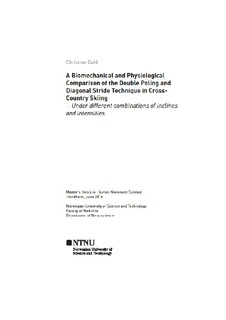A biomechanical and physiological comparison of the double poling and diagonal stride technique in cross-country skiing : under different combinations of inclines and intensities
Master thesis
Permanent lenke
http://hdl.handle.net/11250/2400122Utgivelsesdato
2016Metadata
Vis full innførselSamlinger
Sammendrag
Background: High efficiency is an obvious determining factor for skiing performance. Hence, it is likely that efficiency in the double poling (DP) and diagonal stride (DIA) technique may be affected by incline since the differences in mechanical characteristics between these two techniques might have advantages at different conditions.
Purpose: The purpose of the present study was to compare the DP and DIA technique at moderate (5%) and steep uphill terrain (12%), and to identify how gross efficiency (GE) and physiological responses are related to underlying biomechanical characteristics in these two techniques.
Methods: 15 male elite skiers (age 24.0 ± 2.7 yrs, body height 182.6 ± 4.6 cm, body mass 76.34 ± 6.4 kg) performed four test sequences (DP and DIA at 5%, DP and DIA at 12%) including 3 submaximal intensities performed on equal work rates, while roller skiing on a large treadmill. Oxygen uptake, heart rate and rate of perceived exertion were assessed. Reflective markers were placed on anatomical landmarks, and dynamics and kinematics synchronized and recorded.
Results: DIA at the 12% and DP at the 5% had significantly higher GE (P <0.01) and reduced physiological responses (heart rate and rating of perceived exertion values) (all P < 0.05), compared to all other conditions. Furthermore, longer cycle length and lower cycle rate were found for DP at the 5% and DIA at the 12% at all velocities (all P < 0.05). DIA demonstrated a high duty factor (DF), with correspondingly smaller fluctuations in the velocity of center of mass (VCoM) (all P < 0.05). For DIA, the relative pole power was lower on 12% inclination at all velocities compared to the 5% inclination (P < 0.01).
Conclusion: At the 12% incline, DIA was the favourable technique. The higher gross efficiency and DF, together with the small VCoM fluctuations demonstrated the advantages of using DIA at steep uphill. At the 5% incline, the higher velocity made the propulsion from the legs less efficient and consequently the skiers had to rely more on the poles. Hence, the DP was the preferred technique at moderate incline.
